Review of decompression dive planning mobile apps for technical divers
Recently, I started down a path of discovery into the prehistory of technical and decompression diving. Nitrox only became acceptable in recreational diving around the mid-to-late nineties. A small group of divers, mostly in Florida, had already been experimenting with exotic gases by then.
Here’s an article I found interesting. The GUE blog has some really great articles, BTW.
One of the things that many technical divers don’t realize today is that decompressions tables, especially those including helium (trimix, heliox) were largely unavailable. At least, not like they are now.
If you wanted to dive with trimix, the standard practice was to work with a company to build custom tables based on the dives you planned to do. There were very few options at that time. Companies that produced dive tables mostly worked with commercial diving operations. As a result, custom decompression tables didn’t come cheap.
Fast forward to now, and it is hard to imagine not having easy access to decompression diving tables. Decompression software is widely available and amazingly cheap—even free in some cases. Add to that, mobile apps have made it simple to test any potential dive profile, using virtually any breathing mix, CCR and open circuit, all on your phone.
MultiDeco
If there is a gold standard for technical dive planning apps, MultiDeco is it. MultiDeco is brilliant. The UI is intuitive, configurable options make sense and the detailed views on a tablet are great. It has a customized view that takes advantage of the additional real estate available on the iPad. It also has the ability to print tables straight from the app, which I love.
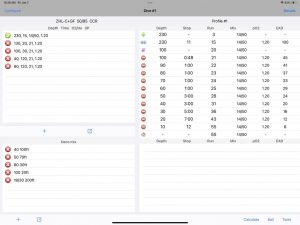
Add to that, MultiDeco includes tools for calculating END, MOD, Best Mix, etc. as well as gas blending and a bunch of other stuff that’s useful in certain situations.
As you would expect, MultiDeco supports Trimix and CCR dives with bailout planning and other advanced configurations.
One feature I like a lot is the ability to calculate a dive profile based on the maximum run time using available gasses. What’s cool about this is it provides a starting point to work up or down from if, say, temperature is a limiting factor, or to quickly assess if cylinder changes will be necessary to execute your desired plan. It also provides a quick means to assess whether your desired dive plan is realistic at all.
To set up MultiDeco, you begin by tapping “Configure” at the upper left hand corner. Here, you’ll select Open Circuit or CCR, along with the deco model. You can choose from several VPM and ZHL options. If choosing VPM, you then use a slider to set your desired level of conservatism. For ZHL, you’ll be presented with fields for GF Lo / Hi.
MultiDeco includes a lot of configuration options. As mentioned, you can select fresh vs salt water, along with the expected choices for metric vs. imperial measurements. Here is also where you’ll set your working and deco SAC rates.
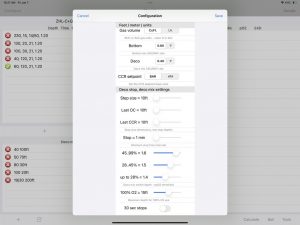
As you scroll through the configuration menu, you’ll find options for multiple ascent rates, time allowances for gas switches or bailout. At the bottom of the screen, you’ll find multiple options for configuring alerts based on criteria you define. Examples are PO2 warnings, OTU & CNS warnings, diluent checks among others. If any alert conditions are present when you generate your plan, these will be present where they occur in the dive plan itself.
The configuration menu is also where you key in details about your dive site elevation, as well as your acclimatized elevation. To put this in context, imagine your dive site is at Late Tahoe, elevation 6229’ above sea level. You would set the dive site elevation in MultiDeco to 6250’. That’s obvious.
Acclimatized elevation is where you’re coming from. For example, if you live in Reno (or have spent over 24 hours there), you would set the acclimatized elevation to around 4200’. Based on these two numbers, MultiDeco is able to more accurately calculate your tissue load than using altitude alone.
For a real-world example, imagine you are driving to Lake Tahoe from the San Francisco Bay. At sea level atmospheric pressure is 14.7psi, however at lake level, it is only 11.7psi, a difference of 3psi.
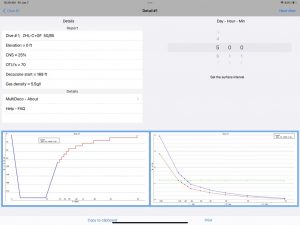
By contrast, in Reno, atmospheric pressure is only around 12.6psi. Going from Reno to Lake Tahoe induces a much lower pressure gradient of 1.1psi. This difference in pressure gradient relative to the dive site has a significant effect on pre-dive tissue loading. A diver that’s acclimatized to Reno will be carrying less inert gas than a diver arriving from San Francisco.
The only mobile apps I know of that take this into account are MultiDeco and Baltic Deco (Baltic Deco only calculates saltwater). By far the most significant factor is the elevation of the dive site. However, the deeper and more complex the dive, the more critical pre-dive tissue loading is. for planning, arriving at a dive site at altitude is much the same as making a repetitive dive.
Once, you have configured the app using your own data, planning dives is simply a matter of learning where everything is. You’ll plug in details about your gear (CCR, tank volumes, bailout, etc.) and gasses. Next, you can add depths and times for the various waypoints during your dive. Tap “calculate” and presto, out comes your table.
Tapping the details button will show you gas use, CNS, OTU’s and more.
In the end, MultiDeco is the only mobile app I’ve seen that accounts for enough variables to plan serious technical dives in just about any environment. I’ve bought at least a dozen technical dive planning apps. While MultiDeco lacks some detail compared to its desktop counterpart, these are not areas that impact 99% of dives.
So, at least right now, if you are going to buy one dive planning mobile app, make it MultiDeco.
What’s good about MultiDeco:
- Excellent layout
- Multiple deco models: VPM-B, VPM-B/E, VPM-B+GFS, ZHL-B+GF, ZHL-C+GF
- Has been around for a long time and is in wide use
- Altitude diving is supported
- CCR, plus multiple bailout scenarios
- Prints beautiful dive tables directly form the app
- Handy additional tools
What’s bad about MultiDeco:
- No graphic view of your dive plan using the phone version (that I know of)
- The website for HHS Software is very unhelpful
Baltic Deco
Baltic Deco is my second favorite mobile dive planning app. I have been using it for years. When I bought it, Baltic Deco was about $7. Today it is $18.99–still a bargain.
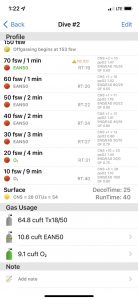
Baltic Deco is easy to learn and use. If you will be diving at altitude, you begin by indicating the surface elevation of your dive site, along with how long it’ll take you to drive there.
Next, you add information about your dives. You begin by including RMV, descent/ascent rate, decompression model and settings for stop intervals and your last stop depth. This is also where you will configure your O2 consumption rates for bottom and decompression phases if you will be diving CCR.
Next, you’ll set the depths, times and gas mix for each bottom phase of your dive. If diving a rebreather, this is where you’ll indicate your set point. As you input dive details, your dive profile will automatically populate further down the screen. This provides a typical decompression table view, showing run time, gas switches and deco stops, along with some additional info like when off-gassing begins, PO2, END/EAD, etc. for each depth.
After that, you can add decompression mixes, or bailout if diving CCR. Since the generated table updates automatically, this is a very handy way to “test” different diving scenarios.

My only complaints about Baltic Deco is there is no tablet version or setting for fresh water. To me, this is stupid, since diving at altitude almost certainly means diving in fresh water. As for the tablet, Baltic Deco works just fine, but it uses the phone layout letterboxed in the middle of the screen.
In practice, there is very little difference in fresh water versus saltwater dive profiles when I generate them using desktop software. However, I would NEVER depend solely on Baltic Deco when diving in fresh water.
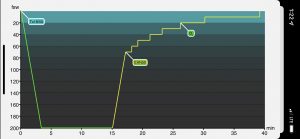
That said, I never depend on a single source for decompression tables anyway. I’ll often run my planned profile using Baltic Deco, and then run it at the dive site using the same settings on my Shearwater dive computers. In actuality, I generally run profiles on the desktop as well as the app. If there are significant differences, I’ll resolve the issue long before filling tanks.
Baltic Deco features:
- Altitude settings including drive time and surface interval pre-dive
- Supports Trimix
- Supports CCR + Bailout
- Unlimited gas mixes
- Decompression algorithms: ZHL16 (A, B, C), VPM-B, VPM-B/GF
- Descent/Ascent Rate
- Stop Intervals: 5-30 feet
- Last Stop Depth: 5-30 feet
- Ability to save nearly unlimited dive plans
iDeco Pro
iDeco Pro is $8.99. In some ways, I find the user interface a bit more intuitive than Baltic Deco. Partly, that’s because it doesn’t have altitude settings, and doesn’t provide a way to store dive profiles. Like Baltic Deco, there’s no fresh water setting either. For the iPad, at least the app fills the screen, but there’s no real tablet version of iDeco either.
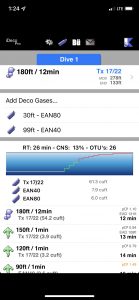
In terms of generated dive profiles, iDeco tends to produce shorter run times compared to Baltic Deco. However, Baltic Deco is much more configurable, so an exact comparison is difficult. I hesitate to suggest Baltic Deco’s longer profiles are more “conservative,” but much of the difference seems to show up in the final deco stop. In general, extending the final stop is akin to adding a safety stop in recreational diving.
That said, running the same dive plan on my Shearwater dive computers at the dive site almost always generates shorter runtimes than either app, so variance doesn’t necessarily indicate one is better.
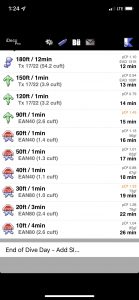
All that said, iDeco Pro is easy to use, but best suited to saltwater dives at sea level. The app does support CCR and Trimix, as well as RMV, gradient factors/conservatism, etc.
iDeco Pro features:
- Supports Trimix
- Supports CCR + Bailout
- Unlimited gas mixes
- Decompression algorithms: ZHL16C, (supposedly supports VPM-B)
- Descent/Ascent Rate: 30’ or 60’
- Stop Intervals: 10’ not configurable
- Last Stop Depth: 10’ or 20’
- Exports clear, printer-ready dive tables
Subsurface-mobile
Unfortunately, Subsurface-mobile is really just a dive log app, without much, if any, dive planning capabilities. I’m only listing it here because I am a big fan of the desktop software. So, while the app has a lot of growing to do, you may find the desktop version useful.
I do find the desktop version of Subsurface a little confusing for dive planning, but it is a very capable and complex program. Last I checked, there were strict warnings about Subsurface being under active development and to anticipate potential errors in decompression profiles.
In my experience, Subsurface-generated dive plans are similar to those generated with other software. I always recommend running planned dive profiles through multiple programs for comparison.
Poseidon Reef
The Poseidon Reef App is very new. I only learned about it because Poseidon sent me an email. It appears the app was developed to support Poseidon rebreathers. Directly within the app, you can access manuals and other support materials. Additionally, the app directly interfaces with supported Poseidon CCR’s for logging dives, and I believe configuring the rebreather itself.
However, for dive planning Poseidon Reef is pretty cool—if you are okay with the user interface. My complaint is entering depths and times is accomplished by tapping and dragging from the bottom corner of your profile where you would begin your ascent. Dragging to the right sets the bottom time, while up/down set the depth.
It’s a bit if a pain, and for whatever reason, I cannot select 150’. It always resets to 149’ in either mode, OC or CCR.
For U-shaped profiles, Poseidon Reef provides run times and stop depths in between Baltic Deco and iDeco Pro (at least, for the dive profiles I tested).
Using Poseidon Reef, here are some observations/quirks:
When selecting deco gasses, you choose the gas and the maximum PO2. The app will assume your gas switch depths based on that. This is fine, since PO2 is the controlling factor anyway.
There is no way (that I can find) to configure more than one bottom depth, so multi-level profiles are a no-go.
You can’t seem to set the bottom depth to 150’ (see above).
There are no settings for altitude of fresh water diving.
All that said, Poseidon has a very long and prestigious history in the diving industry. I tend to trust their data and believe the Reef app will see new features included with future updates.
Also, the app is free. For sea level divers, it is hard to beat.
Poseidon Reef features:
- Supports Trimix
- Supports CCR + Bailout
- Unlimited gas mixes
- Decompression algorithms: ZHL16, DCAP
- Descent/Ascent Rate: Appears to be fixed at 30’
- Stop Intervals: 10’ not configurable
- Last Stop Depth: Any
Deep Tools
Deep Tools looks like a very promising decompression dive planning app. The deal-breaker for me is it’s a subscription. Granted it is only $1.99/mo., but you don’t learn that until you’ve downloaded it. And, since MultiDeco and Baltic Deco are a one-time payment, I’m having a hard time justifying a Deep Tools subscription.
Given that I’m too cheap to pay the $1.99/mo., I can’t comment on the app itself. I included it here because anyone considering Deep Tools should know it is a subscription and not a one-time purchase.
I will say, Deep Tools looks beautiful. It syncs directly with Shearwater dive computers, and also acts as a dive logging program. If there was a lifetime license, I’d buy it.
Easy Deco
This is another subscription-based deco planner. However, there is a lifetime license for $30.99. Otherwise it’s .99 per month or $8.49 annually.
Easy Deco is great for open and closed circuit divers. The user interface is fairly utilitarian, but it is clear and intuitive. There is a 16 compartment graph indicating inert gas loading for every stage of your dive plan. It’s a cool visual, but not enough to justify the price.
What’s especially disappointing is Easy Deco lacks altitude settings (that I could find anyway). So, in the end, I just don’t see anything to set it apart from other dive planning apps—except that it costs more.
iDive Planner
This is a recreational dive planner, that’s not appropriate for technical diving.
Mares Dive Simulator
When I received notice that Mares introduced a dive planning app, I had high hopes. After all, Mares is a major manufacturer that also owns SSI, which is a major training agency, including technical diving training. If any company is equipped to develop a great dive planning app, Mares would be it.
Not so much. Honestly, I just don’t get it. Basically, you use your finger to draw your dive profile on a grid. Your profile is then converted to display on a simulated Mares dive computer. Left of that is a tissue loading bar graph, which I think is cool.
As you drag your finger to various points along your hand-drawn profile, the simulated computer display and tissue loading changes to reflect that point in the dive. For an additional $3.99, you can add Nitrox.
That’s it. You can’t do anything else. I’m not even sure who the app is meant for. It is useless for technical dive planning, and 99% useless for recreational dive planning.
To me, it seems like some executive decided that Mares needed an app, so they set out to make one without any real purpose. My hope is someone will get around to finishing it. When they do, I’ll update my review.
Dive Planner (app.tec-dive.com)
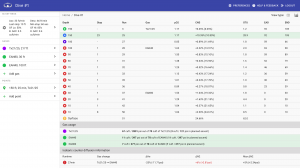
Update (September 9, 2024): I hadn’t thought about Dive Planner in a long time, so I decided to check on its development progress. I am sad to see that the domain is for sale. I couldn’t find a new URL, so I can only assume Dive Planner is no longer a project. If anyone can tell me different, please do. I’ll leave my review here, just in case…
Not to be confused with iDive Planner, Dive Planner isn’t actually a mobile app. It is a dive planning website that provides an excellent mobile experience and respectable capabilities for planning open circuit decompression dives.
What’s good Dive Planner:
- At present, Dive Planner is free. You will need to create an account (name, email address & password) to log in, so it is anybody’s guess what else I’ve signed up for, but
- I really wanted to see Dive Planner in action.
- The mobile experience is great. The page scales and rearranges information based on the the device accessing it, which is refreshing for tablet users.
- Dive Planner supports trimix and multiple deco gases
- Dive Planner supports multiple bottom stages.
- Decompression is based on your choice of ZHL16(a, b or c) with configurable gradient factors.
- It is also intuitive and a snap to learn.
What’s bad about Dive Planner:
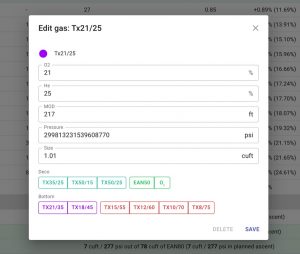
Unless I am missing something, there’s no support for CCR divers. There is a field to include your “Set Point” for each stage, but nothing about Diluent Gases or bailout, and the SAC calculations remain active. And Set Point doesn’t seem to do anything.
Also, there are bugs. For example, when attempting to set your bottom phase and deco SAC rates, you’ll get spaces and weird keyboard behaviors when you type numbers.
If you are out of reach of an Internet connection, you’re out of luck with Dive Planner.
In my opinion, Dive Planner appears to be in early stages of development. I chose to include it here because I like the concept and would like to see it evolve. By introducing Dive Planner here, maybe it will result in a few more divers creating accounts and speed development by helping grow the its user base.
Using technical dive planning apps in the real world
I mentioned earlier that I don’t trust any single app or software for generating dive tables. Bugs happen. Mistakes happen. Also, as I have indicated, every planning app has limitations, especially when dealing with certain types of dives (e.g. altitude, fresh water, etc.). If an app doesn’t account for any variable that’s present in your diving environment, plan or profile, you can’t rely on it.
This is especially true for deep dives, trimix, CCR, etc. As the dive complexity increases, you’ll almost certainly need to do your planning using desktop software. I use Multi-Deco for the desktop, BTW. And, I have probably one of the last remaining functional installations of GAP on a 15 year old NetBook.
Like a lot of divers, I don’t always need to cut printed tables, since I have primary and backup Shearwater dive computers. For simple dives using air and maybe two deco gases, using an app gives me a quick estimate for gas planning and overall run times.
For complex dives, I actually will cut tables, along with contingency tables, to take to the dive site. I usually use them to go over the dive plan with the rest of the team and do a final verification on my Petrels. Everything needs to match. Shearwater should validate the printed profile, and both computers need to produce the same plan, gas usage, etc. If anything is off or doesn’t make sense, we don’t dive until the issue is resolved.
Dive planning apps for travel
I almost exclusively use and rely on mobile decompression planning apps is when traveling. I frequently bring sidemount gear along on trips, since I can always get my hands on AL80’s with air. From a decompression standpoint, air dives at sea level are easy to plan. Sometimes, I’ll deco on whatever highest percentage Nitrox I can get, usually EAN36.
Warm water, ocean dives using air and limited deco gasses easily fit within the capabilities of any mobile dive planning app. Personally, I run them on MultiDeco, Baltic Deco, and sometimes, iDeco Pro to compare the results and catch any errors I may have made while setting up the dives. There are very few variables for these dives, so planning is just a matter of gas planning, managing narcosis and deciding how much decompression I can live with.
I sometimes travel with a rebreather, which automatically adds complexity. Usually, I’ll know in advance what types of dives we will be doing, so I’ll run and print profiles from the desktop well in advance. Once onsite, I’ll run the profiles on the apps and Shearwaters as the final check.
Summing Up
I’m sure someone will pick apart my rather unscientific dive planning app review, but I use these apps in the real world. I’ve purchased or downloaded each one hoping it would provide a better tool for dive planning. So far, the only mobile app I’ve encountered that accounts for all of the types of diving I do is MultiDeco. Baltic Deco would also if the developer would just add a setting for fresh water.
There is little reason to buy all the apps I’ve listed here. I buy them because they are cheap and I am curious and optimistic that one day I’ll discover the next great thing. Also, as a technical diving instructor, it’s good to be able to explain the differences to my students.
My recommendation right now is to buy MultiDeco and Baltic Deco, so you can compare profiles. I can’t tell you how many times I’ve mistyped something or overlooked a variable when setting up a dive. When this happens, there’s usually a significant discrepancy to clue you in that something might be wrong. You can do the same if you have desktop software, or using your dive computers. The important thing is to have some kind of sanity check to identify and sort out errors before getting in the water.
Finally, if I have made any errors, or if you are the author of any of the apps I’ve listed and take issue with my assessment, email me (joe@joescuba.com). I’ll be happy to publish updates or corrections.
If you are a diver and your experience is different than mine, I’m all ears. My goal is to provide a resource to help technical divers make the best possible decisions.


